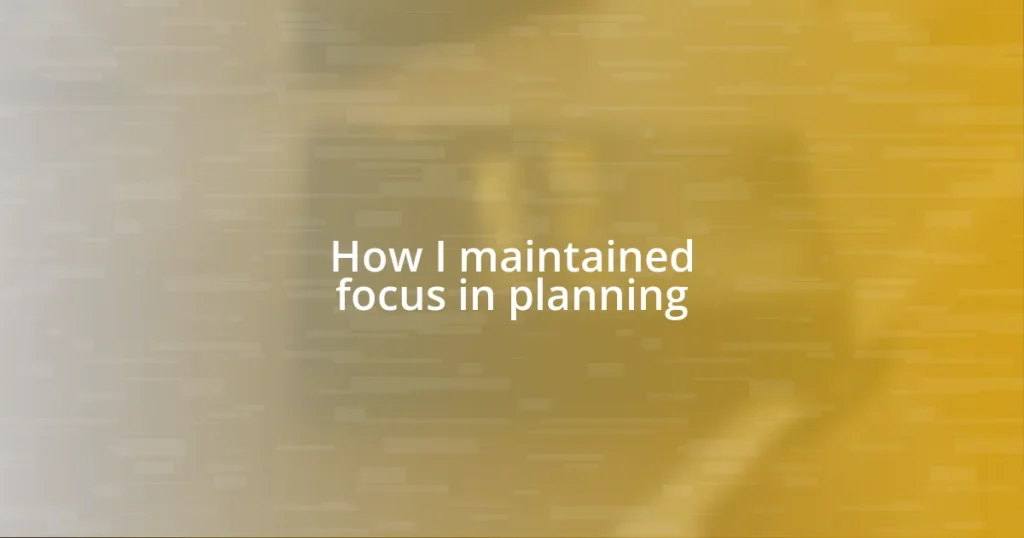Key takeaways:
- Maintaining focus is vital for productivity and creativity; dedicated time slots enhance engagement and results.
- Identifying and reducing common distractions, such as digital notifications and clutter, fosters a more conducive work environment.
- Regularly reviewing progress through journaling and reflection provides clarity, motivation, and insights for continuous improvement.

Understanding the importance of focus
Focus is the cornerstone of successful planning. I remember a time when I had multiple projects going simultaneously, and I felt like a juggler struggling to keep all the balls in the air. In those moments, I understood that if I didn’t hone in on one task at a time, I risked letting everything drop. Have you ever felt that way?
When I truly concentrated on a single project, I noticed a remarkable difference in my productivity. I could dive deeper into the details and develop more thoughtful solutions. It’s fascinating how much clarity you gain when distractions fade into the background, isn’t it? Personally, I found that carving out specific focused time slots each day allowed my mind to really engage, which in turn delivered better results.
Maintaining focus isn’t just about completing tasks; it’s about creating a space where creativity thrives. I’ve seen firsthand how the energy of a focused mind leads to innovative ideas. Think back to a time when you were completely absorbed in something—didn’t it feel almost magical? That’s the power of focus.

Identifying common distractions
Identifying distractions is a pivotal step in maintaining focus. I’ve noticed that certain environments can pull my attention away without me realizing it. For instance, when I plan in a bustling coffee shop, the chatter and movement often make it hard to concentrate. Understanding these distractions is crucial because it allows me to take proactive steps to mitigate them.
Here are some common distractions I’ve identified in my own experience:
- Digital notifications: Constant pings from emails or social media can disrupt my thought process.
- Cluttered workspace: A messy desk can lead my mind to wander, causing me to lose focus on the task at hand.
- Personal thoughts: Sometimes, my own worries and to-do lists intrude, reminding me of everything I haven’t done.
- Multitasking: Trying to juggle several tasks at once often leaves me feeling scattered.
- External noise: Background sounds that I can’t control can really pull me out of my zone.
Recognizing these distractions empowers me to create a more conducive planning environment. When I eliminate or reduce these disruptions, I find that my planning sessions become much more productive and enjoyable.

Setting clear planning goals
Setting clear planning goals is essential to maintaining focus and drive. When I approached a particularly challenging project, I remember sitting down and setting specific, measurable objectives. This wasn’t just a checklist; it was about creating a roadmap that felt tangible and inspiring. By breaking big goals into smaller milestones, I could track my progress easily, which kept me motivated. Have you experienced that sense of achievement when ticking off a completed task?
Moreover, I learned to set deadlines for each goal. Initially, I resisted time constraints, feeling they might stifle my creativity. However, I discovered that having a timeline helped me to prioritize my efforts and keep a steady pace. I often reflect on those moments when I felt the urge to procrastinate. Setting clear deadlines transformed that urge into a burst of focused action. What strategies have you used to enforce deadlines?
Lastly, I realized the importance of reviewing my goals regularly. I make it a habit to assess not just what I’ve accomplished but also whether the goals still resonate with my overall vision. This reflective practice became a routine for me—a way to recalibrate and ensure my planning remained aligned with my evolving priorities. It’s amazing how often revisiting my goals sparked new insights and creativity. Have you ever revisited your goals and found they needed a refresh?
| Aspect | My Experience |
|---|---|
| Setting Specific Goals | Created clear roadmaps that fueled motivation |
| Establishing Deadlines | Helped maintain focus and avoid procrastination |
| Regular Review | Informed adjustments that enhanced creativity |

Utilizing time management techniques
Utilizing time management techniques has been a game changer for me in the planning process. One powerful method I often rely on is the Pomodoro Technique. This approach involves working for 25 minutes and then taking a short five-minute break. I find that these intervals keep my mind fresh and focused. It’s fascinating how my productivity spikes during those concentrated bursts. Have you ever tried this technique? The sense of urgency it creates often leads me to accomplish more than I anticipated.
Another technique I’ve embraced is the time-blocking method. By setting aside specific blocks of time for particular tasks, I’ve witnessed significant improvements in my ability to stay on track. I remember a time when I allocated two hours solely for brainstorming ideas for a project. This structure allowed me to dive deep into my thoughts without the usual interruptions. The satisfaction of seeing my ideas flow freely during that dedicated time was incredibly rewarding. It makes me wonder: could this structured approach lead you to deeper insights as well?
Lastly, I’ve learned to prioritize tasks using the Eisenhower Matrix, which helps distinguish between what is urgent and what is important. This visual method has saved me from the anxiety of overcommitment. I once tackled a project that seemed overwhelming because it felt “urgent.” Once I plotted my tasks, I realized that it wasn’t as pressing as I believed, allowing me to focus on what truly mattered. Have you ever had that moment of clarity? It’s empowering to shift from a reactive mindset to a more strategic one, ensuring that my energy is directed toward things that genuinely align with my goals.

Implementing a distraction-free environment
Creating a distraction-free environment was a game changer for me. I vividly recall a time when I transformed my workspace into a sanctuary of focus. Removing clutter and minimizing distractions like mobile notifications made a significant difference. I even added plants and warm lighting; the ambiance seemed to cradle my thoughts, enabling me to concentrate fully. Have you ever realized how your environment can shift your mindset?
A crucial step for me was establishing “do not disturb” hours where I communicated my availability to others. This practice took some adjustment for my colleagues, but I stood firm, knowing that those uninterrupted hours greatly enhanced my productivity. I remember feeling a mix of liberation and anxiety at first, but over time, I embraced the space these quiet hours created. It’s a refreshing reminder that protecting your time is a form of self-respect. How have you navigated setting boundaries in your own work setting?
I also experimented with sound control, which turned out to be an unexpected ally. I discovered that playing instrumental music or ambient sounds could help drown out background noise without being distracting. On particularly intense planning days, I would don my headphones, and a specific playlist would signal my brain that it was time to dive deep into work. It feels almost magical to find that rhythm, doesn’t it? What techniques have you tried to tune out distractions?

Regularly reviewing progress
Regularly reviewing my progress has been an essential part of maintaining focus. I can’t tell you how many times I felt lost in my responsibilities until I created a routine for reflection. At the end of each week, I take time to sit down and assess what I’ve accomplished. I found that naming my successes, however small, fosters a sense of motivation that fuels my next steps. Have you ever experienced that uplifting feeling of recognizing your own progress?
During my reviews, I ask myself targeted questions that guide my thinking. I’ve discovered that breaking down my goals into specific milestones makes this process more effective. For instance, after completing a project phase, I reflect on what went well and what could be improved. This introspection not only highlights my strengths but also draws attention to areas needing adjustment. Have you ever taken the chance to sit with your experiences like this? It can be eye-opening.
In my journey, I’ve embraced journaling as a tool for progress review. Writing down my thoughts and feelings about various tasks offers clarity that often eludes me during the hustle. There were weeks when I thought I was spinning my wheels, but those journal entries revealed patterns and insights that guided me forward. It’s fascinating to see my own evolution documented on paper. How has your own practice of reflection impacted your approach to tasks?

Adjusting strategies for better focus
Adjusting my strategies for better focus often required me to be open-minded and willing to explore new techniques. I distinctly remember a period when I realized that rigid schedules were stifling my creativity, so I began implementing a more flexible approach. By allowing myself time blocks dedicated to both focused work and spontaneous breaks, I discovered a newfound energy that made my planning sessions remarkably more productive. Have you ever found that stepping away for a bit can sometimes provide just the clarity you need?
Another adjustment that truly resonated with me was prioritizing tasks using the Eisenhower Matrix, a simple yet effective tool. I learned to differentiate between what was urgent and what was important, which immediately helped reduce my overwhelm. For example, I once spent hours on an urgent email that, in retrospect, wasn’t essential to my larger goals. Reflecting on this, I realized that fueling my focus on significant tasks aligns with my broader vision and keeps me engaged. Isn’t it liberating to recognize when we’re pouring effort into the wrong areas?
I also became intentional about shifting my mindset towards setbacks. There was a time I faced a major hurdle in a project, and I felt a wave of frustration wash over me. Instead of letting that derail my focus, I began asking myself what I could learn from the situation. This pivot in thinking transformed challenges into valuable insights, allowing me to approach future obstacles with renewed determination. How do you process the bumps in your journey, and can they be tools for improvement rather than deterrents?















